Miele 04 610 490 User Manual
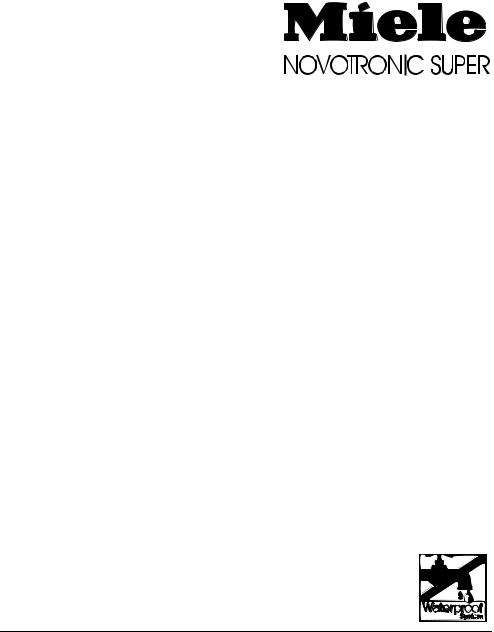
Operating instructions
for Washing machine W 937 WPS
It is essential to read these operating instructions before installing or using the machine, to avoid the risk of accident, or damage to the machine.
Q
M.-Nr. 04 610 490

Contents
Guide to the machine. . . . . . . . . . . . . . . . . . . . . . . . . . . . . . . . . . . . . . . . . . . . . . . 3
Warning and Safety Instructions . . . . . . . . . . . . . . . . . . . . . . . . . . . . . . . . . . . . . 5
Preparation for use
Help to protect our environment . . . . . . . . . . . . . . . . . . . . . . . . . . . . . . . . . . . . . . . 8 Installation . . . . . . . . . . . . . . . . . . . . . . . . . . . . . . . . . . . . . . . . . . . . . . . . . . . . . . . 36 Plumbing . . . . . . . . . . . . . . . . . . . . . . . . . . . . . . . . . . . . . . . . . . . . . . . . . . . . . . . . 42 Electrical connection . . . . . . . . . . . . . . . . . . . . . . . . . . . . . . . . . . . . . . . . . . . . . . . 46
Operation
Washing environmentally and economically . . . . . . . . . . . . . . . . . . . . . . . . . . . . . . 9 How to wash correctly . . . . . . . . . . . . . . . . . . . . . . . . . . . . . . . . . . . . . . . . . . . . . . 10 To change a programme . . . . . . . . . . . . . . . . . . . . . . . . . . . . . . . . . . . . . . . . . . . . 14 Adding or removing washing after programme start . . . . . . . . . . . . . . . . . . . . . . . 15 Adding detergent . . . . . . . . . . . . . . . . . . . . . . . . . . . . . . . . . . . . . . . . . . . . . . . . . . 16 Fabric conditioners/starch formulations. . . . . . . . . . . . . . . . . . . . . . . . . . . . . . . . . 17 Programme selection . . . . . . . . . . . . . . . . . . . . . . . . . . . . . . . . . . . . . . . . . . . . . . . 18 Programme sequence . . . . . . . . . . . . . . . . . . . . . . . . . . . . . . . . . . . . . . . . . . . . . . 20 Care symbols . . . . . . . . . . . . . . . . . . . . . . . . . . . . . . . . . . . . . . . . . . . . . . . . . . . . . 22 Additional options . . . . . . . . . . . . . . . . . . . . . . . . . . . . . . . . . . . . . . . . . . . . . . . . . 23 Delay start/time left display . . . . . . . . . . . . . . . . . . . . . . . . . . . . . . . . . . . . . . . . . . 24
Maintenance
Cleaning and care . . . . . . . . . . . . . . . . . . . . . . . . . . . . . . . . . . . . . . . . . . . . . . . . . 25 Problem solving guide . . . . . . . . . . . . . . . . . . . . . . . . . . . . . . . . . . . . . . . . . . . . . . 29 After sales service . . . . . . . . . . . . . . . . . . . . . . . . . . . . . . . . . . . . . . . . . . . . . . . . . 35
Programmable functions
Programmable functions . . . . . . . . . . . . . . . . . . . . . . . . . . . . . . . . . . . . . . . . . . . . 47
Consumption data . . . . . . . . . . . . . . . . . . . . . . . . . . . . . . . . . . . . . . . . . . . . . . . . 49
Technical Data . . . . . . . . . . . . . . . . . . . . . . . . . . . . . . . . . . . . . . . . . . . . . . . . . . . . 50
2
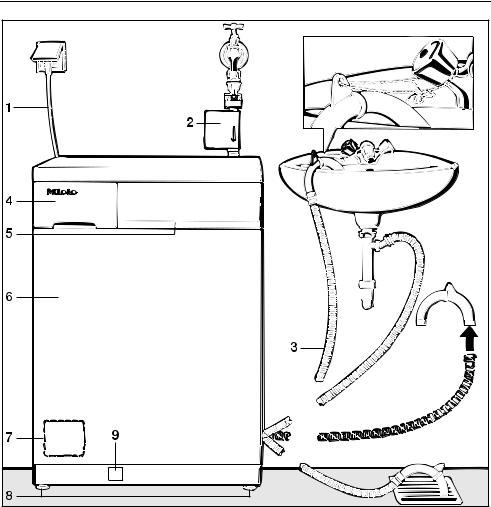
Guide to the machine
1 |
Electric supply cable |
6 |
Drum door |
2 |
Inlet hose with "Waterproof" system |
7 |
Access panel for drain pump and filter |
3 |
Flexible drain hose (with detachable |
8 |
Four height adjustable feet |
|
swivel elbow) |
9 |
Access panel for energency door re- |
|
|
||
4 |
Detergent dispenser drawer |
|
lease and emptying |
5 |
Facia panel with controls |
|
|
3
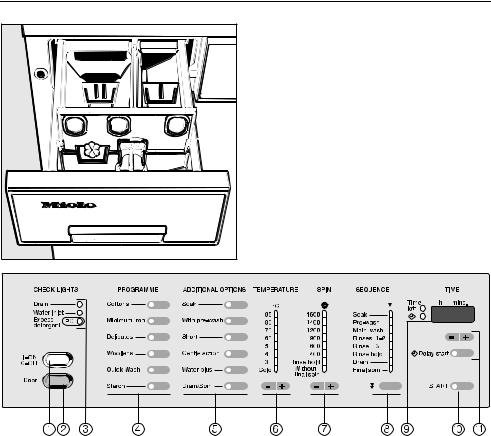
Guide to the machine
Detergent dispenser drawer
Compartment i Pre-wash
Compartment j main wash
Compartment p (with extra lid) for fabric conditioner or liquid starch formulation
b |
"I-On/O-Off" button |
h |
SPIN SPEED display |
|
|
|
with “ $” and “ >” touch pads |
c |
"Door" button |
|
|
|
|
i |
PROGRAMME SEQUENCE display |
d |
CHECK LIGHTS |
|
with “ *” touch pad. |
e |
Touch pads for PROGRAMMES |
j |
"TIME" display |
f |
Touch pads for ADDITIONAL |
k |
“START” touch pad |
|
OPTIONS |
|
|
g |
TEMPERATURE DISPLAY and |
l Delay start d touch pad |
|
|
with “ $” and “ >” touch pads |
||
“ $” and “ >” touch pads.
4

Warning and Safety Instructions
Read the operating instructions before using this machine for the first time. They contain important information about the safety, use and maintenance of the machine. This will avoid the risk of accidents and damage to the machine.
Keep these operating instructions in a safe place and ensure that new users are familiar with the content. Pass them on to any future owner of the machine.
Correct usage
Only use the washing machine to wash items which are declared by the manufacturer to be machine-wash-
able on the wash-care label.
Any other applications may be dangerous. The manufacturer is not liable for damage resulting from improper use or operation.
This appliance should not be operated by children. Supervise its use
by the elderly or infirm.
Technical safety
Before setting up the machine, check it for any exernally visible
damage.
Before connecting the machine, ensure that the connection data on
the data plate (fusing, voltage and frequency) matches the mains electricity supply. If in any doubt, consult a qualified electrician.
The electrical safety of this machine can only be guaranteed
when continuity is complete between the machine and an effective earthing system which complies with local and national regulations. It is most important that this basic safety requirement is regularly tested by a qualified electrician.
The manufacturer cannot be held responsible for the consequences of an inadequate earthing system.
For safety reasons do not operate this appliance on an extension
cable. Danger of overheating.
The machine is built in accordance with current safety requirements.
Unauthorised repairs could result in unforeseen dangers for the user, for which the manufacturer cannot accept responsibility. Repairs should only be undertaken by a Miele approved engineer.
The machine is only completely isolated from the electricity supply
when:
–it is switched off at the wall socket and the plug is withdrawn, or
–it is switched off at the mains, or
–the mains fuse is withdrawn.
5

Warning and Safety Instructions
The Miele "Waterproof system" protects from water damage provided the following conditions have been met:
–the machine is correctly plumbed in and connected to the electricity supply.
–if a fault has been identified, the machine must be examined by a competent person before further use and repaired if necessary.
Faulty components must only be exchanged for Miele original spare
parts. Only when these parts are fitted can the safety standards of the machine be guaranteed.
If the connection cable is damaged it must be replaced by a spe-
cial Miele cable.
Use
Do not install your washing machine in rooms where tempera-
tures below freezing may occur. Frozen hoses may burst under pressure. The reliability of the electronic control system may be impaired at temperatures below freezing point.
In countries where there are areas which may be subject to infesta-
tion by cockroaches or other vermin, pay particular attention to keeping the appliance and its surroundings in a clean condition at all times. Any damage which may be caused by cockroaches or other vermin will not be covered by the appliance guarantee.
Before using the machine for the first time, check that the transit fit-
ting at the rear of the machine has been removed (see section on "Installation"). During spinning, a transit fitting which is still in place may result in damage to both the machine and adjacent furniture or appliances.
Turn off the stopcock if the machine will be left for any length of
time (e.g. holiday), especially if there is no floor drain (gully) in the immediate vicinity.
Flooding danger.
If hooking the drain hose into a wash basin, check that the water can drain off quickly enough to prevent the sink from overflowing.
Make sure the drain hose is secure, so that the force of the water flowing out of the hose does not dislodge it. Otherwise this will result in flooding.
Take care to ensure that foreign objects (e.g. nails, needles, coins,
paper clips, etc.) do not find their way into the machine with the washing (e.g. in pockets). Foreign objects can damage components of the machine, which in turn can result in damage to the washing.
6

Warning and Safety Instructions
If the correct amount of detergent is dispensed, the machine should not need to be descaled. If, however,
you do wish to descale the machine only use proprietary non-corrosive descaling agents and strictly observe the instructions. Consult the Miele Customer Service Department.
Textiles which have been pretreated in solvent based cleaning
agents must be thoroughly rinsed in clean water before being washed in the machine.
Never use solvent based cleaning agents in this machine, as this may
result in damage to component parts and create toxic fumes. Such detergents also pose a fire and explosion hazard.
Only use dyes specified by the manufacturer as being suitable for
use in a washing machine. Always observe the manufacturer’s instructions carefully.
Dye removers may contain sulphur compounds which cause damage such as corrosion to the machines. Do
not use dye removers in this machine.
For machines with a ’porthole’ door, remember that the porthole
glass will be hot when washing at very high temperatures. Do not let children touch it during a hot wash programme.
Always make sure the drum is stationary before reaching in to
remove washing. Reaching into a moving drum is extremely dangerous.
This machine is intended for domestic use, and the guarantee is
on this understanding. If the machine is used in a commercial environment, the user is responsible for ensuring conformity to all relevant regulations.
Accessories
Accessory parts may only be fitted when expressly approved by
Miele. If other parts are used, guarantee, performance and product liability claims may be invalidated.
Disposal of your old machine
Before discarding an old machine unplug it. Render the plug useless.
Cut off the cable directly behind the appliance to prevent misuse.
7

Help to protect our environment
Disposal of the packing material
The transport and protective packing is mostly manufactured from the following recycled or re-useable materials:
–corrugated paper/card
–polystyrene - CFC-free
–untreated surplus wood
–chipboard, contains no phenolic resins
–polyethylene foil (PE)
–packaging straps: polyropylene (PP)
Rather than just throwing these materials away, please take them to the nearest local authority collection point for specific waste.
Disposal of your old machine
Old machines may contain material which can be reclaimed or recycled. Please contact your dealer, your local waste collection centre or scrap merchant about potential recycling schemes.
Ensure that the machine presents no danger to children while being stored for disposal.
See the appropriate section in the Warning and Safety instructions.
8

Washing environmentally and economically
Caring for the environment means saving water, energy and detergent when washing but without compromising on results.
The key to a good wash result is finding the best combination of amount of detergent, temperature, length of programme and the machine’s technology.
If necessary, some programmes take longer to achieve this effect. With the "Hydromatic" system, the drum can revolve at different speeds. Longer and slower action together with pauses for steeping, work towards a good result.
The automatic load control facility ensures the correct water level for the type of fabric and laundry load being washed. Sometimes it even appears that there is no water in the drum.
Normally, main wash is sufficient for a clean result, so a pre-wash is not automatically included in the programmes. If it is wanted, a simple press on the pre-wash selector includes it.
Economy tips
To help you wash most economically, remember the following tips:
–The automatic load control facility allows you to wash individual loads of between 1 and 5 kg. Ideally wash with the maximum load specified for each programme. This uses the energy to the best advantage.
–Only use the correct amount of detergent required for the water hardness level in your area, according to the detergent manufacturer’s recommendations.
–If washing is not heavily stained, select a lower temperature setting than indicated on the wash care label but do not additionally select "Short".
–Use the "Short wash" option for washing that is only very lightly soiled, but do not additionally reduce the temperature.
–Using the additional "Soak" option allows you to reduce the temperature used in the main wash.
9
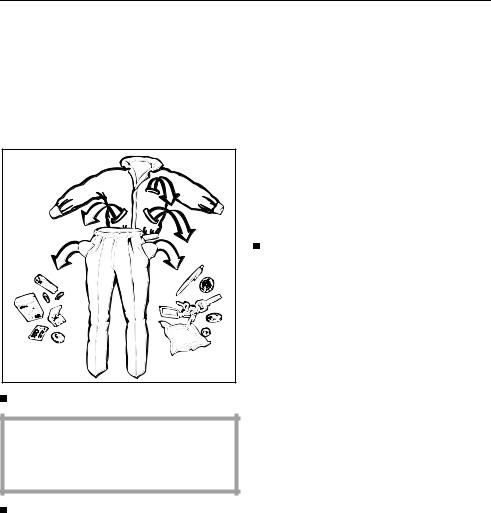
How to wash correctly
The headings numbered (1,2,3,...) show the operating sequense and can be used as a brief guide.
Before washing
1Prepare the wash load
Empty all pockets.
Foreign objects (e.g. nails, coins, paper clips etc) can cause damage to textiles and components in the machine.
Sort the washing
Most garments have a textile care label in the collar or side seam. Sort the washing by care label symbols. (See the Section on these symbols for their explanation).
Only wash items in this machine which are declared by the manufacturer as being machine washable on the textile care label.
Dark textiles often contain excess dye and should be washed separately several times before being included in a mixed load.
Delicate textiles should be washed separately in a delicates programme.
Any loose wiring in bras etc., should be removed or sewn in.
Only wash textiles made from wool or wool mixtures if the textile care label states that they are suitable for machine washing.
Pre-treating the washing
Badly soiled areas, e.g. collars and cuffs, and water soluble stains can be pre-treated with bar soap, liquid detergent or detergent mixed into a solution or paste.
With particularly stubborn stains ask your Dry Cleaner for advice.
Do not use solvent based cleaning agents in this machine.
2Open the door by pressing on the "Door" button.
10

How to wash correctly
3Load the drum.
Unfold washing and load loosely in the drum. To achieve best results it is advisable to make up mixed loads consisting of both large and small items.
This improves the washing effect and helps distribute the load evenly to keep the machine stable and reduce the noise level during spinning. Overloading reduces the wash result and causes more creasing.
Maximum load weights are noted below:
COTTONS . . . . . . . . . . . . . . . . . . 5.0 kg
MINIMUM IRON . . . . . . . . . . . . . . 2.5 kg
DELICATES/SYNTHETICS . . . . . 1.0 kg
WOOL . . . . . . . . . . . . . . . . . . . . . 1.0 kg
QUICK WASH . . . . . . . . . . . . . . . 2.5 kg
Curtains:
Remove lead weights and strips or place in a laundry bag.
Any loose wiring in bras etc., should be removed or swen in.
Woollens, knitted garments and jeans: Turn inside out, if the manufacturer recommends it.
3Close the drum door.
Make sure that there is no obstruction between the drum door and seal.
4Open the stopcock.
5Add detergent.
See Section on Detergent for details.
To start a programme
1Press the I-ON/0-OFF button.
2Select the required basic programme.
See page 13 for details of the Memory function.
3Select an additional option if required.
For a delayed start, see Section on the "Delay start" and "time left display" for details.
4Select the temperature by pressing the “ $” or “ >” touch pad beneath the temperature display.
5Select the spin speed by pressing the “ $” or “ >” touch pad beneath the spin display.
6Press the START button.
11
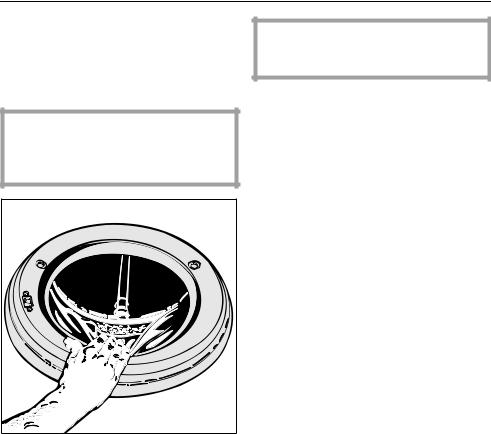
How to wash correctly
After washing
1Press the “Door” button.
2Remove the washing.
Make sure the drum is empty, items left behind could shrink, or discolour other items in the next wash.
4Close the drum door.
Only remove washing from the machine once the drum has stopped turning, otherwise you may seriously injure yourself.
Otherwise there is a danger of objects being placed inadvertently in the drum. If these remained unnoticed and were washed in the next load, they could damage the washing.
5Press the I-ON/0-OFF button.
3Check the folds in the door seal for any small articles e.g. buttons which might be lodged there.
12

How to wash correctly
Memory-Function
As soon as the basic programme has been selected, the indicator lights for the ADDITIONAL OPTIONS, TEMPERATURE and SPIN SPEED set the last time this programme was used automatically illuminate.
To run the programme with the selections already shown:
Press the START button.
To cancel or change any of the selections retained in the memory and displayed:
–ADDITIONAL OPTIONS - to cancel, press on the illuminated touch pad; to change, press on the touch pad for the option required.
–SPIN - press the spin “$” or “>” touch pad .
–TEMPERATURE - press the temperature “$” or “>” touch pad.
The additional options, temperature and spin speed can only be selected within the permitted range of the basic programme chosen.
Note:
If a touch pad is pressed which is not accepted by the basic programme, the indicator light will go out when the touch pad is released (if selecting an additional option), or the command will be completely ignored (if selecting a temperature and spin speed).
13

To change a programme
Changing a programme once started:
Changing a basic programme once started:
This is only possible by starting again completely.
Switch the machine off and then on again and select a new programme.
Changing additional options, temperature and spin speed:
This can be done if the change is compatible with the basic programme.
Exception: If the programme locking child safety feature has been set, changes are only possible by starting again.
To skip a programme stage:
Press the “*” touch pad when the programme reaches the stage you want to skip:
The programme will then continue in the next programme stage. The corresponding segment in the programme sequence display illuminates.
To repeat a programme stage:
Switch the machine off and on again.
Select the programme.
Press the “START” button.
Keep pressing the “*” touch pad until the programme stage to be repeated has been reached.
14

Adding or removing washing after programme start
Washing can be added or removed after the programme has already started, when using the following programmes:
–COTTONS
–MINIMUM IRON
–QUICK WASH 40°C
Press the "Door" button in and hold it until the door springs open.
–In the SEQUENCE display the segment for the relevant programme is illuminated.
Add or remove items.
Shut the door.
– The programme continues.
COTTONS and QUICK WASH 40°C
The door can be opened in the following programme stages:
–Soak
–Pre-wash
–Main wash, but only if the suds temperature is less than 55°C .
Please note that the door can only be opened when the suds temperature is less than 55°C .
QUICK WASH
The door can be opened during the following programme stage:
– Main wash
Washing cannot be added later if using the following additional options or programmable functions:
–“Water plus" (the water level is increased)
–Programme lock (e.g. to prevent children from opening the door during the wash process).
15

Adding detergent
All modern detergents produced for automatic washing machines are suitable, including liquid, compact (concentrated) and special application detergents. Use dispensing aids, e.g. balls, if these are supplied with the detergent. Woollens and knitwear containing wool mixtures should be washed using a detergent specifically designed for washing woollens. Amounts of detergent are recommended on the packaging. The right amount to dispense will depend on the following:
–The quantity of the washing.
–The water hardness level (check with your local water supplier).
–The level of soiling.
Water Hardness
Hardness |
Type of |
Total |
°dH |
range |
water |
hardness |
(German) |
|
(hardness) |
(mg/l) |
|
|
|
|
|
I |
soft |
0 - 130 |
0° - 7° |
|
|
|
|
II |
medium |
130 - 250 |
7° - 14° |
|
|
|
|
III |
hard |
250 - 380 |
14° - 21° |
|
|
|
|
IV |
very hard |
over 380 |
over 21° |
|
|
|
|
It is important to dispense the
correct amount, because...
...too little has the following results:
–The washing will not be properly clean and will in time become grey and hard to the touch.
–Greasy particles cling to the washing.
–Lime deposits on the heater elements.
...too much results in the following:
–Excessive foam.
–Low level of agitation.
–Poor washing and rinsing results.
Water is taken in through compartment i in the pre-wash.
Water is taken in through compartment j in the main wash. If the capacity of compartment j is insufficient for the amount of detergent needed (e.g. in very hard water areas), the Customer Service Engineer can adjust the machine so that water and detergent can also be taken into the main wash through compartment i.
Water Softeners
A water softener can be used to cut down on the use of detergents in water hardness ranges II-IV. Dispense according to the amount specified on the packaging. First add detergent and then the water softener.
Use a quantity of detergent as for soft water.
If you wash using several components (e.g. special application detergents), we recommend dispensing the agents into compartment j in the following order:
1.Detergent
2.Water softener
3.Stain salts
This way the agents are distributed more efficiently.
16
